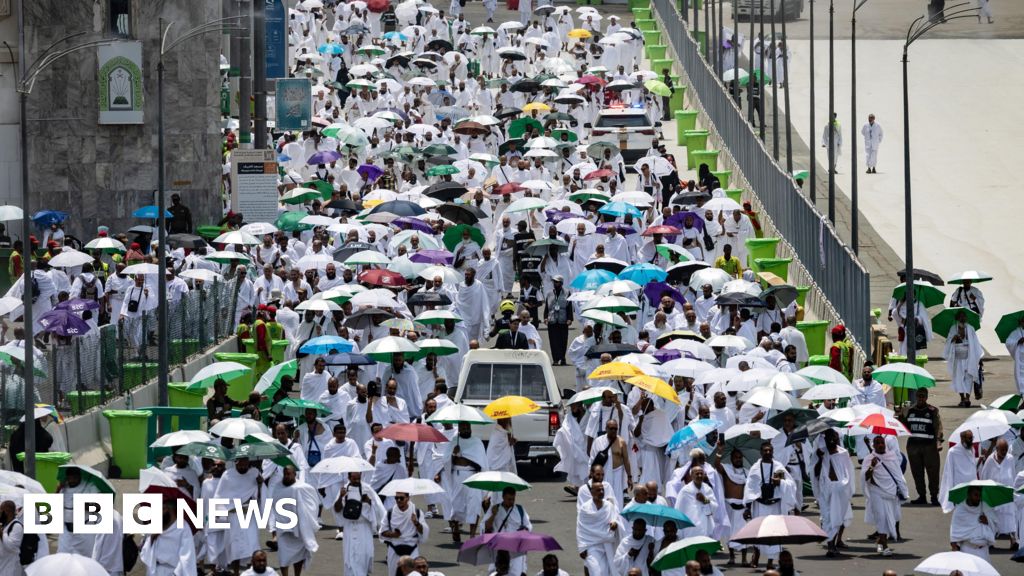go through Zahra Fatima and BBC World Service, bbc news
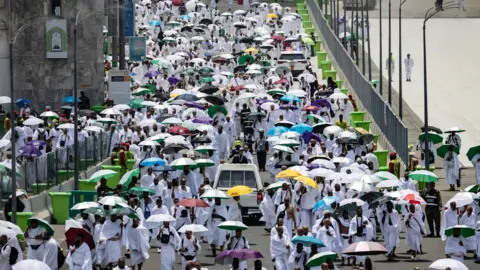 Getty Images
Getty ImagesHundreds of people are believed to have died during the hajj in Saudi Arabia, most of them caused by extreme heat that soared to more than 51 degrees Celsius (123 degrees Fahrenheit).
Agence France-Presse quoted an Arab diplomat as saying that 658 Egyptians had died. Indonesia said more than 200 of its citizens had died. India said 98 people were known to have died.
Deaths have also been confirmed in Pakistan, Malaysia, Jordan, Iran, Senegal, Sudan and the autonomous Kurdistan region of Iraq. According to the Wall Street Journal, the United States believes that several Americans were killed. Friends and relatives have been searching for the missing people at hospitals and posting messages online.
The impact of the death toll has been growing. On Saturday, Egypt’s Prime Minister Mostafa Madbouly revoked the licenses of 16 tourism companies and handed their managers over to prosecutors on charges of allowing illegal pilgrimages to Mecca.
Jordan said on Friday it had detained several travel agencies that facilitated unofficial travel for Muslim pilgrims to Mecca. Meanwhile, Tunisian President Kais Saied fired his religious affairs minister after local media reported the deaths of 49 Tunisians, many of them unregistered pilgrims.
Hajj is the annual pilgrimage for Muslims to the holy city of Mecca. All Muslims who are financially and physically able must complete the Hajj at least once in their lifetime. Saudi Arabia said about 1.8 million people were taking part this year.
According to Agence France-Presse, more than half of the deaths were unregistered pilgrims who attended hajj through informal channels, leaving them unable to use cooling facilities such as air-conditioned tents and buses.
Saudi Arabia has tightened security measures for hajj in recent years but still faces criticism that it is not doing enough, especially against unregistered pilgrims. There has been no public comment on the deaths.
However, AFP quoted a senior Saudi official as saying that 577 people died in the two busiest days of the hajj alone, when pilgrims prayed in the sun on Mount Arafat on Saturday and in Mina on Sunday. During the “Stone the Devil” ceremony.
“This occurred under adverse weather conditions and very severe temperatures,” the official said.
Here are some factors that lead to death.
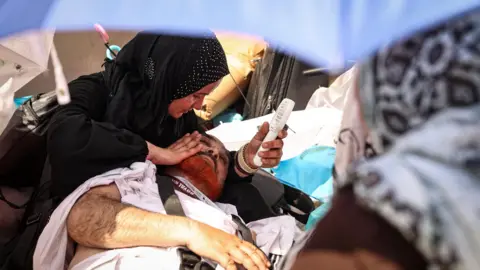 Getty Images
Getty Imagesextremely hot
An unprecedented heat wave in Saudi Arabia is blamed for the high death toll.
Despite warnings from the Saudi Ministry of Health to avoid heat and stay hydrated, many pilgrims have fallen victim to heat stress and heatstroke.
“It was only by the mercy of God that I survived because it was very hot,” Nigerian pilgrim Aisha Idris told BBC News International.
“I had to hold an umbrella and keep dousing myself with Zamzam (holy water),” she said.
Another pilgrim, Naeem, has reportedly died of heat stroke, and her family is searching for answers.
“Contact with my mother was suddenly interrupted. We spent several days searching and only to learn that she died during the Hajj,” her son told BBC Arabic News, adding that they would honor her burial in the Mecca wishes.
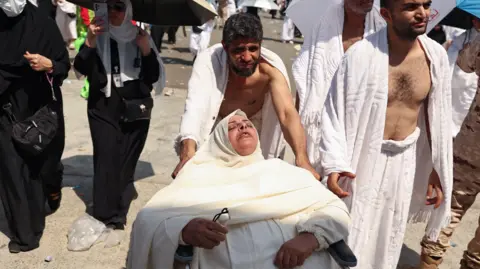 Getty Images
Getty ImagesPilgrims are at risk due to the unfamiliar heat, strenuous physical activity and wide open spaces. Many are also elderly or unwell.
However, deaths due to heat during the Hajj are not new and have been recorded since the 1400s.
Scientists warn that global warming will make the situation worse.
“Hajj has been performed in hot climates for more than a thousand years, but the climate crisis is exacerbating these conditions,” Carl-Friedrich Schlessner of Climate Analysis told Reuters.
His research shows that with global temperatures rising 1.5 degrees Celsius above pre-industrial levels, the risk of heat stroke during the Hajj could increase fivefold.
Overcrowding and hygiene issues
According to some reports, poor management by Saudi authorities has exacerbated the extreme situation, leading to crisis in many areas designated for pilgrims.
They said accommodation and facilities were poorly managed, with tents overcrowded and lacking adequate cooling and sanitation facilities.
Amina (pseudonym), 38, from Islamabad, said: “It is hot in Mecca and there is no air conditioning in our tent. The cooler installed does not have water most of the time.”
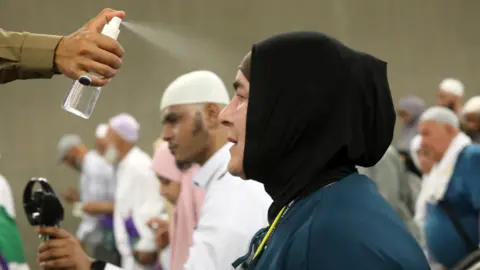 U.S. Environmental Protection Agency
U.S. Environmental Protection Agency“It was very suffocating in these tents, we were sweating profusely, it was a horrific experience,” she added.
Fauziah, a pilgrim from Jakarta, agreed, saying: “Many people fainted due to overcrowding and overheating in the tents.
She welcomes improvements but believes “this is the best hajj organization yet”.
However, Saudi Arabia’s health minister highlighted the resources allocated to ensure the well-being of pilgrims.
These include 189 hospitals, health centers and mobile clinics with a total capacity of more than 6,500 beds and more than 40,000 medical, technical, administrative staff and volunteers, a government statement said.
transportation
Pilgrims are often forced to trek long distances in sweltering heat, which some blame on roadblocks and poor management.
Muhammad Acha, a hajj organizer for a private group, said a typical pilgrim might have to walk at least 15 kilometers a day during the summer. This puts them at risk of heat stroke, fatigue and lack of available water,
“This is my 18th Hajj and in my experience, the Saudi controllers are not mediators. They control but do not help,” he said.
“In earlier years, U-turns to enter the tents were open, but now all these routes are closed. Therefore, an ordinary pilgrim, even staying in an A-category tent in Zone I, has to walk 2.5 kilometers to reach them in the hot summer weather tent,” he explained.
“If there is an emergency on this route, no one will find you for 30 minutes. There are no life-saving arrangements and there are no water points along the way,” Acha added.
 Getty Images
Getty Imagesundocumented pilgrim
In order to perform Hajj, pilgrims must apply for a special Hajj visa.
But despite attempts by Saudi officials to crack down, some people are still trying to make the five-day pilgrimage without proper documentation.
Pilgrims without proper documentation tend to avoid authorities, even if they need help.
The “unofficial hajj” event is believed to have resulted in overdose deaths, with authorities blaming overcrowding in some tents.
“We suspect that those using non-hajj visas have infiltrated into hajj areas,” said Mustolih Siradj, chairman of Indonesia’s National Hajj and Umrah Committee (Komnas Haji).
Saad Al-Qurashi, adviser to the National Hajj and Umrah Committee, told the BBC: “Anyone without a Hajj visa will not be tolerated and must return [their] nation.
He noted that informal pilgrims are identified using Nusuq cards, which are issued to official pilgrims and contain a barcode for entry into the holy site.
 Getty Images
Getty ImagesElderly, infirm or sick pilgrims
One of the reasons why many people may die during the Hajj each year is that many pilgrims reach the end of their lives after saving a lifetime of money.
Many Muslims also hope that if they die, it will be during the Hajj – since burial in the holy city after death is considered a blessing.
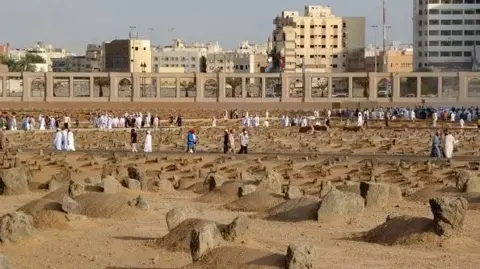 Getty Images
Getty ImagesWhat if someone dies during Hajj?
When a pilgrim dies during the Hajj, the death is reported to the Hajj Mission. They use a wristband or neck ID to confirm their identity. They then obtained a doctor’s note and Saudi Arabia issued a death certificate.
Funeral prayers are performed at important mosques such as the Masjid al-Haram in Mecca or the Prophet’s Mosque in Medina, depending on the situation. The bodies were washed, wrapped and moved to a refrigerator provided by the Saudi Arabian government, all costs being borne by the Saudi Arabian government.
The tombs are simple, unmarked, and sometimes contain multiple bodies in one place. Cemetery books list who is buried where so family members can visit graves as needed.
The Saudi Arabian government said it ensured “a dignified and respectful burial process” with the help of different groups and the Red Crescent Society.

